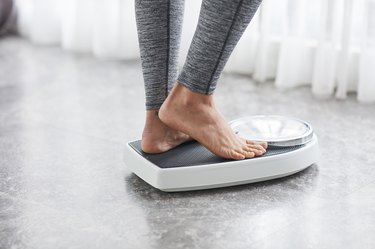
Your body makes steroids naturally. These chemicals — typically hormones — are used by your organs, tissues and cells to carry out their functions. Steroids like prednisone can also be man-made. This potent drug is given to people whose bodies can't make enough steroids and is also used to treat illnesses like lupus, multiple sclerosis, cancer and severe allergic reactions. The long list of potential prednisone side effects includes weight gain, so if you're taking the drug, follow steps to combat prednisone weight gain and lose some of the weight you've put on.
Prednisone Weight Gain
Video of the Day
Weight gain is a widespread effect of prednisone. In a 2006 study in the journal Arthritis and Rheumatism, weight gain was the most commonly reported side effect among the 2,446 participants on long-term steroid use.
Video of the Day
According to UCSF Health, prednisone weight gain is usually due to an increase in appetite — and therefore an increase in calorie intake — and fluid retention. Additionally, other side effects of the drug, including extreme fatigue and muscle weakness, may make it more difficult for you to exercise and burn off extra calories.
Dose and Duration
Prednisone side effects, including weight gain, are dose-dependent, according to a 2009 study in Annals of the Rheumatic Diseases. Although any dose could potentially cause weight gain, doses of 5 mg or more per day were most likely to cause an increase in weight.
Additionally, long-term use will cause more marked weight gain than short-term use. According to UCSF Health, the higher the dose and the longer the duration, the worse the side effects.
Read more: Why Do People Gain Weight on Prednisone?
Prednisone and Diet
Your diet is a very powerful tool when it comes to fighting weight gain while on prednisone. To reduce fluid retention, UCSF recommends reducing your sodium intake and increasing your potassium intake. Eating too much salt raises your blood sodium level and makes it hard for your kidneys to remove excess fluids. The electrolyte mineral potassium helps flush sodium out of the body to create a more balanced environment and reduce fluid retention.
Current dietary recommendations advise keeping salt intake below 2,300 mg per day. However, prednisone causes your body to be more sensitive to salt's effects, and it's a good idea to go even lower, limiting salt intake to 1,500 mg daily.
High-sodium foods to avoid while taking prednisone include junk foods, fast food, prepared foods, restaurant foods and a lot of boxed and packaged products. Eat primarily fresh fruits and vegetables and lean meats prepared at home with herbs and spices instead of salt. When choosing packaged foods, read the nutrition label and choose brands with the lowest amount of sodium per serving.
Eating plenty of fresh fruits and vegetables will automatically increase your potassium intake. Some of the foods highest in potassium include:
- Cantaloupe and honeydew melon
- Baked potatoes
- Raisins
- Spinach
- Dates
- Lima beans
- Grapefruit
- Milk
- Tomatoes
- Squash
- Bananas
Controlling Hunger and Reducing Calories
A low-sodium, high-potassium diet has dual benefits for prednisone weight gain. Not only does it help reduce fluid retention, but it tends to be lower in calories and higher in fiber, which can help keep you feeling fuller longer and reduce food cravings.
UCSF Health also recommends eating smaller meals more frequently, focusing on lean protein from chicken, fish and beans and reducing your intake of carbohydrates — except those from fruits and vegetables.
Although you don't have to keep track of everything you eat, you need to keep your calorie intake below your calorie expenditure to create a calorie deficit. Taking in more calories than you burn leads to weight gain.
Get Regular Exercise
It's hard to exercise when you don't feel well, but any amount of activity is better than none. Take a walk every day for as long as you're able. As you start to feel better, increase the frequency, duration and intensity of your exercise activities. Focus on cardio at first, but then work in some strength training exercise, which will help replace body fat with lean muscle mass and strengthen your bones.
Read more: Prednisone Side Effects
- MedlinePlus: Prednisone
- UCSF Health: ILD Nutrition Manual: Prednisone and Weight Gain
- Annals of the Rheumatic Diseases: Dose-Related Patterns of Glucocorticoid-Induced Side Effects
- Arthritis and Rheumatism: Population-Based Assessment of Adverse Events Associated With Long-Term Glucocorticoid Use
- Annals of the Rheumatic Diseases: Safety of Low-Dose Glucocorticoid Treatment in Rheumatoid Arthritis
- WebMD: Bulk Up Your Steroid Smarts
- Blood Pressure UK: Salt's Effects on Your Body
- Harvard Health Publishing: Potassium and Sodium Out of Balance
- Vital Record: You Asked: How Much Sodium is Too Much?
- Mayo Clinic: Weight Loss: Feel Full on Fewer Calories